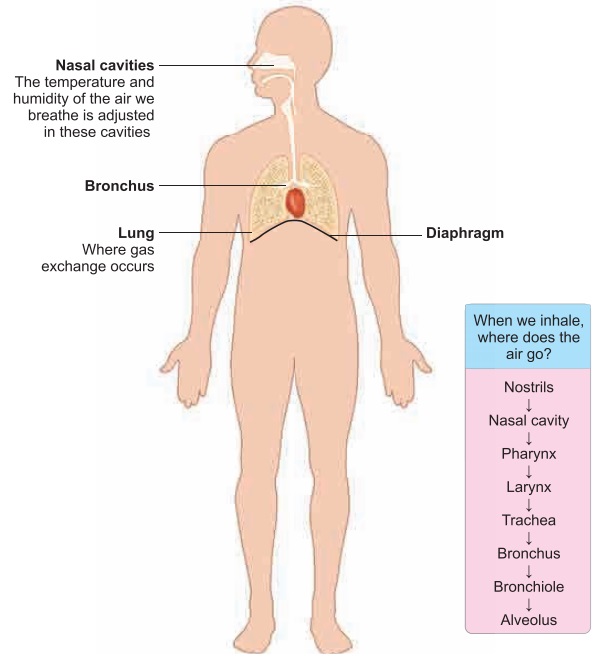Human Organ systems | Term 2 Unit 6 | 6th Science - Respiratory System | 6th Science : Term 2 Unit 6 : Human Organ systems
Chapter: 6th Science : Term 2 Unit 6 : Human Organ systems
Respiratory System
Respiratory System
Respiratory system
is involved in exchange of respiratory gases and there by helps us to breathe.
The human respiratory system consists of nostrils, nasal cavity, pharynx,
larynx, trachea, bronchi and lungs. It helps in the movement of air in and out
of the body. Exchange of O2 and CO2 occurs between air in
the lung and blood. The entry of food into the wind pipe is prevented by a flap
like structure called Epiglottis.
Lungs
Lungs are the main
respiratory organ. They are located within the chest cavity. The trachea, commonly called windpipe, is a tube
supported by cartilaginous rings that connects the pharynx and larynx to the
lungs, allowing the passage of air. The trachea divides into
right and left bronchi and enter into the lungs. They divide further and ends
in small air sacs called alveoli. The lungs are covered by a double layered
pleura. Diffusion of gases (O2 and CO2) occurs
across the alveolar membrane.

Exchange
of gases by the respiratory system involves three different processes such as;
1. External
Respiration: Intake of O2
from the air and releasing of CO2 from the lungs occurs through
nostrils.
2. Internal
Respiration: Taking in of
oxygen and giving out CO2. The circulatory system transports O2
and CO2 to and from all parts of the body.
Hemoglobin in the red blood cells (RBCs)
transport O2 and CO2.
3. Cellular
Respiration: Cells take in O2 and release CO2
Activity
5:
Aim: To prove that exhaled air is rich
in carbon- di- oxide
Materials
required: Two glass jars
with lime water and a straw
Procedure:
Leave the first jar with lime
water undisturbed, blow air in to the second jar with the help of a straw
Observation: Lime water turns milky in
few seconds in the second jar. The CO2 gas alone can change the lime
water into milky white.
Conclusion:
Carbon-di-oxide is present
in the air that we exhale.
Each lung has about 300 million air sacs or alveoli.
Yawning
helps us to take in more amount of O2 and to give out CO2
Related Topics